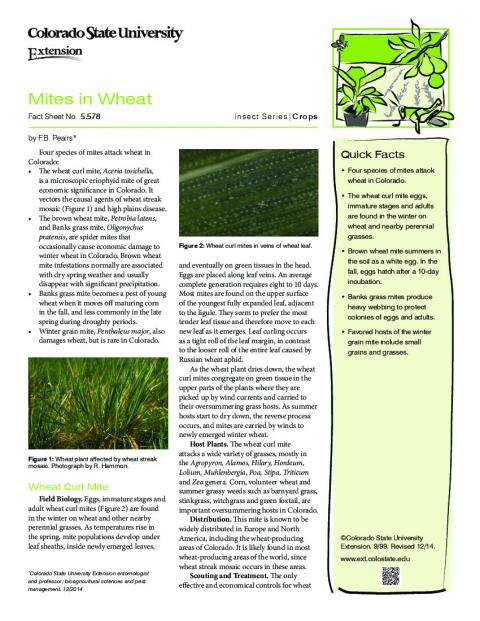Quick Facts
• Four species of mites attack
wheat in Colorado.
• The wheat curl mite eggs,
immature stages and adults
are found in the winter on
wheat and nearby perennial
grasses.
• Brown wheat mite summers in
the soil as a white egg. In the
fall, eggs hatch after a 10-day
incubation.
• Banks grass mites produce
heavy webbing to protect
colonies of eggs and adults.
• Favored hosts of the winter
grain mite include small
grains and grasses.
©Colorado State University
Extension. 9/99. Revised 12/14.
www.ext.colostate.edu
Four species of mites attack wheat in
Colorado:
• The wheat curl mite, Aceria tosichella ,
is a microscopic eriophyid mite of great
economic significance in Colorado. It
vectors the causal agents of wheat streak
mosaic (Figure 1) and high plains disease.
• The brown wheat mite, Petrobia latens ,
and Banks grass mite, Oligonychus
pratensis , are spider mites that
occasionally cause economic damage to
winter wheat in Colorado. Brown wheat
mite infestations normally are associated
with dry spring weather and usually
disappear with significant precipitation.
• Banks grass mite becomes a pest of young
wheat when it moves off maturing corn
in the fall, and less commonly in the late
spring during droughty periods.
• Winter grain mite, Penthaleus major , also
damages wheat, but is rare in Colorado.
by F.B. Peairs*
Mites in Wheat
*Colorado State University Extension entomologist and professor; bioagricultural sciences and pest management. 12/2014
Wheat Curl Mite
Field Biology. Eggs, immature stages and
adult wheat curl mites (Figure 2) are found
in the winter on wheat and other nearby
perennial grasses. As temperatures rise in
the spring, mite populations develop under
leaf sheaths, inside newly emerged leaves,
Figure 1: Wheat plant affected by wheat streak mosaic. Photograph by R. Hammon.
Figure 2: Wheat curl mites in veins of wheat leaf.
and eventually on green tissues in the head.
Eggs are placed along leaf veins. An average
complete generation requires eight to 10 days.
Most mites are found on the upper surface
of the youngest fully expanded leaf, adjacent
to the ligule. They seem to prefer the most
tender leaf tissue and therefore move to each
new leaf as it emerges. Leaf curling occurs
as a tight roll of the leaf margin, in contrast
to the looser roll of the entire leaf caused by
Russian wheat aphid.
As the wheat plant dries down, the wheat
curl mites congregate on green tissue in the
upper parts of the plants where they are
picked up by wind currents and carried to
their oversummering grass hosts. As summer
hosts start to dry down, the reverse process
occurs, and mites are carried by winds to
newly emerged winter wheat.
Host Plants. The wheat curl mite
attacks a wide variety of grasses, mostly in
the Agropyron, Alamos, Hi l ar y, Hordeum,
Lolium, Muhlenbergia , Poa, Stipa, Triticum
and Zea genera. Corn, volunteer wheat and
summer grassy weeds such as barnyard grass,
stinkgrass, witchgrass and green foxtail, are
important oversummering hosts in Colorado.
Distribution. This mite is known to be
widely distributed in Europe and North
America, including the wheat-producing
areas of Colorado. It is likely found in most
wheat-producing areas of the world, since
wheat streak mosaic occurs in these areas.
Scouting and Treatment. The only
effective and economical controls for wheat
Fact Sheet No. 5.578 Insect Series| Crops

